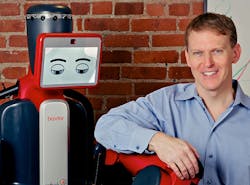Manufacturing 2015: 7 Thought Leaders Share Their Predictions
It was the year 2000, and we three manufacturing geeks -- we called ourselves the "White Socks Guys -- were the skunks at the garden party, an Aspen futurist gathering of experts drawn from politics, the media and technology assembled to talk about trends and, in particular, the U.S.’s New Economy.
Madeleine Albright was there, and Bill Clinton flew in to deliver a high-ticket speech. The hot topic was globalization and how the U.S. was going to move to a singular focus on innovation within the new service economy -- toward designing the stuff that boats and planes would bring back to us, produced and neatly packaged by unknown and faceless low-wage Mill Girls in some foggy offshore factory.
Michael Marks, then president of Flextronics, spoke about what it took to be in the electronics business in the U.S., and the Gartner guy offered some statistics, but the pressure to accept the globalization vision of an out-sourced U.S. economy sans basic production capabilities was overwhelming. We were outnumbered.
Collateral Damage
Fourteen years later, however, the numbers and the challenges have clearly emerged from the fog. We’re happily seeing renewed interest in making, not just designing, product in the U.S. It’s enough to make a Mill Girl stand up at her machine and cheer!
We three white-socks guys knew back then what would happen to cities and towns all over the U.S. when the factories shut down –- that not everyone would find a new service economy job. Even the call centers were outsourced! And there was the collateral human damage –- longer commutes to out-of- town jobs and families dislocated by bad real estate deals.
We’re happily seeing renewed interest in making, not just designing, product in the U.S.
But the biggest loss -- the unlearning of what it takes to build and run a healthy production operation –- remains with us. According a spring 2013 report by Josh Bivens at the Economic Policy Institute, in 2011 international trade depressed wages for non-college educated workers by 5.5%, costing the average worker $1,800.
Bivens found that as labor-intensive industries moved to developing nations, the demand for labor in the U.S. decreased. The result? Reduced wages for non-college educated workers, increased demand in the U.S. for professionals, skilled labor and capital, and a bigger gap between the rich and poor, as incomes for college-educated workers rose.
So much for the working middle-class…
But the tide rolls in, and the tide rolls out, and the white socks guys are feeling the pull, the positive shift away from bemoaning the loss of U.S. factories and workers, to the more immediate challenge of re-discovering our manufacturing intelligence. That’s a very positive challenge, one that my CEO friends welcome.
Let’s look ahead!
Read on for the 2015 predictions of seven manufacturing thought leaders. Then let’s crank up the machines and build something!
2015 Will Not be 'The Year of Additive Manufacturing'
Mike Opal, Sr. Evangelist Global Cloud Alliances
Microsoft Corp.
2015 will not be "The Year of Additive Manufacturing" -– that's still five to ten years off. However, 2015 will be the year manufacturers wake up to the impact 3-D printing will have on their supply chain and business model.
Pushing "print" and having a product built somewhere across the globe remains science fiction, but manufacturers who do not examine their supply chain through the lens of 3-D printing do so at their peril.
Manufacturers that can find a way to begin inserting or replacing a piece or product in their supply chain with an Additive Manufacturing process will be well positioned to realize pricing and time-to-market advantage as the technology advances over the next three to five years. Those who fail to examine with open eyes and then ready their supply chain for the era of Additive Manufacturing will be at a significant competitive disadvantage.
This shift is equally true for the new manufacturing business model, which will allow a consumer or business to conduct an online search for a product (or more likely a piece of a product), then purchase the design and print locally. Additive manufacturing flips on its head the well-established business of creating a product, building a way to produce it, and finding a way to sell and ship this product.
Those companies who understand the new model and who have planned for it and created a unique value proposition for their brands will benefit from a tremendously efficient and streamlined process. Those companies who don't will lose.
Three Predictions for Packaging
Kevin Howard, Sr. Packaging Engineer/Consultant
Packnomics, LLC
1. Reducing Packaging's Environmental Footprint
The biggest move in packaging will be further reduction in the environmental impact of packaging materials. We’ve seen introductions of many new materials -- bamboo molded pulp cushioning, molded mycelium root cushioning, starch based cushioning, PLA thermoformed plastics (biodegradable and made from renewable resources), and the recently announced Air Plastic (Newlight Technologies), where carbon is extracted from the air or smoke stacks and then utilized to form plastic pellets. There will be more!
Still much bigger opportunities exist for companies to reduce their environmental footprint. All these new materials cost more than current conventional materials -- look at electro-mechanical products that use cushioning, for example. It’s great to replace rarely-recycled foam with some groovier material choice, but it doesn't improve the other serious piece of environmental impact: the size of the final package. The best way to minimize the size of the package is to improve the robustness of the product and ensure that internal laboratory tests truly reflect the actual hazards consistently found in distribution.
Look for companies to establish bare product fragility goals, and watch for cushioning to be minimized. Whether the cushion material is traditional foam or a new material, box size will continue to shrink and packaging material will be minimized. Winners will combine the right materials with Outside-In design methodology to produce lowest landed cost with the lowest environmental footprint.
2. More and New Testing Will Update Packaging Standards
Testing is about to get better, and packaging standards will change significantly. Many standards are based on tests and reports from the 1960's, long before overnight shipments and super high-volume, high-speed package processing. Although laboratory testing should reflect actual hazards found within a specific distribution system for a specific product, most companies still rely on test standards from various organizations. Drop testing, for instance, is problematic because it can lead to excessive packaging. Watch for testing to change as companies test for specific conditions in their own supply chains.
The winners will collect better information on how products are actually handled and whether or not there are consistent damages. Good testing will replicate consistent field failures, and not cause damages that don't occur in the field. Companies will decrease their dependence on harsh tests that create high shipping and material costs and move to a more “custom” packaging design that fits particular products and supply chains.
3. Products and packaging will be designed for the regions to which they are bound
Here’s a colorful illustration. Agilent Technologies Inc. (IW 500/160) is the largest producer of $150,000 liquid and gas chromatographs. Their fastest growing markets are in developing nations like China, where the company realized that products and packaging were insufficient for the conditions presented.
We watched 150-pound products strapped onto individual pallets, then hand-carried off trucks, across courtyards, and up three flights of concrete stairs. As two guys walked one unit to the bottom of the stairs, the unit fell over onto the concrete landing, a perfect flat drop from 30 inches onto the unit's side. Although testing standards say to never test free-fall drops from this height when a pallet is attached because the package will be picked up by a forklift, this assumption simply isn't true in places like China.
Plus, the government test lab the unit was headed for was brand-new and filled with millions of dollars of high-tech equipment -- but the windows were open, a layer of dust coated every surface, and the wiring was not grounded. The high-tech U.S. engineers who designed these products could never have imagined such conditions, and one has to wonder how well the units would operate amidst that dust and pollution. If U.S. companies hope to do well in their fastest growing markets, they must design specifically for their customers.
"Big Data" Analytics Will Spread to More Operations Areas
Dr. David Simchi-Levi
Co-Director, Leaders for Global Operations
MIT
I see the expansion of data-driven decisions to new operations areas. This change is enabled by availability of data, new analytics that combine machine learning and optimization, improved computational capabilities and access to cloud-based resources. Here are three examples:
1. Revenue management
I recently worked with online retailer Rue La La, an e-commerce retailer that offers extremely limited-time discounts (aka “flash sales”) on designer apparel and accessories. The focus was on using internal and external data to develop a demand forecasting and price optimization tool utilizing machine learning technology. This has changed the way the company prices its products from cost-plus to analytics, resulting in over 10% increase in revenue. I am currently working with a few other companies on similar applications.
2. Supplier risk management
Collaborating with Ford, we developed and implemented a Decision Support System for Risk Management using optimization methods based on the concept of the Risk Exposure Index (REI) that I introduced a few years ago (see a review of the REI method in the Harvard Business Review).
The REI enables companies for the first time to fully quantify their maximum risk exposure from natural disasters or any other unpredictable supply chain disruptions. It specifically assesses for each node, or site, in a given supply chain the resulting financial impact, such as loss of revenue or loss of profit, or operational impact, such as loss of production volume.
3. New business model
Rolls-Royce has developed a new business model in which the company combines engine sensors’ data and advanced analytics to spot engine problems before breakdowns occur. This allows the company to offer customers the ability to monitor engines and charge based on usage time.
The company continuously monitors the performance of more than 3,700 jet engines worldwide. Repair, maintenance and replacement are all the responsibility and cost of Rolls-Royce. Service revenue now accounts for about 70% of the civil-aircraft engine division’s annual revenue.
The combination of big data and advanced analytics, including machine learning and optimization, will bring opportunities in three areas: 1) customized offerings, as in the case of Rue La La; 2) improved operations, such as the Ford supplier risk mitigation strategies; and 3) new business models such as the one developed by Rolls-Royce and others.
Coming in 2015: Big Data Breakthrough in Financials, Better Talent Mapping and Drone Delivery Tests
David J. (Joe) Armstrong, Principal,
Inventory Curve, LLC
1. Big Data Breakthroughs
Organizations will make significant breakthroughs in financials as they segue to smart data mining of profitability by customers and customer segments, combined with transaction and operational effectiveness and the costs associated with serving different customers and segments.
Many companies routinely look at customer profitability based on sales and revenues, but far fewer look at the cost-to-serve by customer based on services delivered, order composition and transactions.
Smart data entails linking top-line sales and revenue with cost-to-serve at the individual customer and customer segment level. Results will lead to better segmentation and management of processes and services serving different segments, which will improve overall profitability and reduce rework, an important cost driver.
2. Talent Gap Mapping
Does a supply chain and manufacturing talent or skills gap really exist? Much of what is called a talent or skills gap exists only at a local level and may be the result of unrealistic expectations.
We will continue to better map labor supply and demand imbalances at the local level and implement creative solutions that address local conditions. These solutions will include revised wage/salary schedules, training programs and partnerships with local educational institutions.
3. Drone Delivery Testing
The FAA will relax restrictions on drones to provide organizations like Amazon limited opportunities to evaluate and test delivery operations and evaluate effectiveness, capacity and related costs. At the same time that delivery by drones in commercial operations is being evaluated, disaster and emergency response organizations such as FEMA and search-and-rescue organizations will make significant strides using drones in disaster situations.
Coming Soon: Virtual Simplicity in Real Time
Bill McDermott
CEO, SAP
1. The enterprise will become increasingly more virtual
Business is different today. Companies own less infrastructure, inventory and manufacturing equipment than ever. They’ve outsourced everything from customer service to supply chain -– and a growing portion of their workforce isn’t even on their full-time payroll.
When it comes to manufacturing, they operate on more flexible models that require rapid assembly of resources on a project basis to address the biggest challenges of the moment. Then –- just as quickly –- these organizations must disassemble processes to make their businesses more agile and profitable.
Companies will increasingly look externally for innovations. They will tap call centers and third-party logistics providers to enable new models for customer engagement; outside design partners and knowledge workers for product and service innovations; and contract manufacturers for assembling products new and more efficient ways.
2. Businesses will have to simplify to survive
This “Virtual Enterprise” model may bring a level of agility, but it also increases complexity. Complexity is the most intractable CEO challenge of our time. Business is no longer about executing a process within a company, but across an entire value chain.
It’s not only about the intelligence within an organization, but the intelligence of entire communities.
It’s not about automating and doing things faster, but tapping collective insights and best practices to do things better -– and in entirely new ways.
To truly enable the shift, business will look to simplify everything from routine tasks to more sophisticated aspects like planning and innovating.
3. Real-time business networks will become as popular as social networks.
Networks that connect companies with the applications, intelligence and partners they need to make things go will help simplify the work environment.
Personal networks from Facebook to Uber have made it simple for consumers to shop, share and consume in new and more informed ways. When shopping on Amazon, for instance, you don’t worry about connecting to individual merchants, banks or credit card companies because it’s all done for you within the network.
Business networks provide an equally simple and scalable way for companies to discover, connect and collaborate with the trading partners and resources they need to operate in today’s dynamic world. Look at SAP’s business network. With a few clicks, companies can shop for goods and services, place and manage orders, and pay for them –- all electronically. They can view and manage spend across all major categories and manage their entire workforce -– temporary and full-time employees alike. They can engage customers across multiple channels -– all through a single, connected platform.
Just as network-powered upstarts like Square and Airbnb are creating new models that transform entire industries, business networks are leveraging the automation, scale and ubiquity of the cloud to further simplify the way complex business gets done. Companies that tap into them will enable the agility, speed and efficiency required to manage their operations in a new and dynamic way and stay ahead of the competition.
Robots Get Real
Jim Lawton, CMO
Rethink Robotics
In the nitty-gritty world of the factory floor, a different kind of face will step up to the production line. In 2015, a new category of smart, collaborative robots will join the manufacturing workforce based on their ability to work as humans do: trained by colleagues on a multitude of jobs; able to accommodate the inherent variability in the environment and ready to get real work done.
That real work lies in an estimated 95% of tasks that have been beyond the reach of traditional automation—until now. Requiring compliance like a human arm and the ability to “feel” one’s way into a fixture, examples of these tasks include placing a printed circuit board into an integrated circuit test machine or tending a wood planer at a cabinet maker. Robots driven by software, gears, joints and sensors become smart machines that are cost effective and able to perform tasks in human-like ways.
By year end, these robots will add yet another layer of value—playing a role at the intersection of operations and big data. In the abstract, robots are containers of massive amounts of telemetry data that when combined with other structured and unstructured data can provide powerful historical and predictive insights about making manufacturing better. Able to collect, sort and analyze the data, as part of broader data and analytics platform, the robots will make it possible for human colleagues to do what they do best: interpret the information and create strategies and actions that make the most of it.
IT Heads for the Cloud
Thomas Trappler
Sr. IT Commodity Manager
University of California
In the next five years over 50% of all IT processes and functions that were previously run in-house will have moved to the cloud. This will be the result of both intentional enterprise transitions, and staffers' turning to easily accessible cloud computing services to more effectively and efficiently accomplish their work responsibilities.
One-hundred percent of software suppliers will offer either a cloud version of their products or cloud add-ons. Some processes and functions will remain in-house, however, because of data sensitivity or business criticality. The IT staff will redirect its effort toward processes and functions that will either differentiate the organization from competitors, or protect the organization from catastrophic data breaches or loss.
About the Author
Patricia Moody
Publisher
Patricia E. Moody is a writer and manufacturing and supply management consultant with over 30 years of management consulting, hundreds of articles and interviews, speeches, and 12 books to her credit. She is the publisher of Blue Heron Journal, an online resource for thought-leaders and decision makers.
Named by FORTUNE magazine one of the "Ten Pioneering Women in Manufacturing," she was featured on CNN's "21ST CENTURY WITH BERNARD SHAW." Her consulting client list includes Motorola, Respironics, British Petroleum, Waste Management, and Cisco. She consulted to Johnson & Johnson's McNeil Consumer Labs during the Tylenol poisoning crisis and is credited with saving the company. She has an MBA and an Honorary Doctorate.
A pragmatic visionary and self-confessed technology freak, she has little patience for laggards who have dwelled too long on one-note methodologies. She believes that a combination of technology, clear process, and progressive leadership, funded by smart spend management can save endangered companies.








